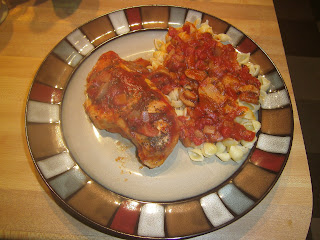So, I broke my curry spoon the other day. It sounds odd, I know, especially since I had it long before I learned to make curry. In fact, I believe I originally got the spoon as a set when I was putting together my first set of camp cookware. I had always loved camping, but I was just getting old enough to do it myself. Though I had no idea what I was doing at the time, I decided to put together a backpack of "necessary items" to keep packed in case the urge to hit the woods ever, well, hit. All in all, despite my then lack of experience with backpacking and survival camping, I think I did pretty well, as I had actually managed to live a week in the wilderness with everything in that small pack, but I learned very quickly that "smaller is better"--therefore, my big spoon was relegated to my small collection of home cookware.
In short, I've had this spoon longer than I've had my wife. For a guy, I suppose that's saying something.
I bring this up because, despite the amount of material objects we tend to collect as we live our lives, the fact of the matter is, we usually only utilize a small portion of the pile. I have a fully stocked arsenal of kitchen tools and gadgetry, but on a daily basis will mostly use only a handful of items. I have a favorite bamboo turner, a go-to chef's knife, a whisk that I save for special occasions, and the aforementioned curry spoon, may it rest in peace. This is the reason why I am going through the act of simplifying. There are two adults, four kids, and a cat living in this house, and I still have a couple of totes in the basement packed with dinner/cookware that we haven't opened since we moved up to the Upper Peninsula. Once I get everything I need in the Makerspace's kitchen, I'm going to have a whopper of a yard sale.
My curry spoon has been a go-to utensil throughout my years of learning to cook. I gave it that title when, in the early 2000's, I mastered the fine art of simple, Indian curries. Since then, its blue had been forever stained by the brutal onslaught of turmeric, but it never faltered in the face of adversity; not even when I made my first vindaloo. It has been more than two decades since I have spoken to my friend, Madhi, to whom I owe a great deal of my addiction to Indian cuisine, but I would hope that she would be proud of my accomplishments.
In the noble spirit of adventuring, when you learn to do something properly, you also come up with ways to shortcut the heck out of it. I could go to great lengths telling you how to do a proper curry (and will, no doubt, in the very near future), but for now, how about a little cheater recipe, in memory of my old friend, the curry spoon.
CURRY IN A HURRY
1 Tbsp. Olive Oil
1/2 Cup Chicken Broth
1/2 Cup Milk
3-5 Tsp. Red or Tandoori Curry (to taste)
2 Tbsp. Mango Chutney (hot or mild)
Chili Powder (to taste)
2 Boneless Chicken Breasts, cubed
1 Medium Onion, Chopped
1 Cup Instant Rice
Heat the oil in a saute pan until it starts to shimmer, then cook the onion, stirring constantly, until it just becomes tender. Set the onion aside in a bowl and cook the chicken in the remaining olive oil, sprinkling with chili powder (note that I turn the chicken red with chili powder, but I'll leave the amount up to your taste). Once the chicken is cooked thoroughly, remove it to the same bowl as the onion.
Mix together the broth, milk, curry, and chutney, then add it to the pan. Bring it to a simmer over medium heat, stirring occasionally. Once the sauce reaches a gentle simmer, add the chicken and onion, cooking for about a minute more.
Serve over a bed of rice.
The color of the final product will depend on the type of curry powder you use and the fervor with which you apply chili powder to the chicken as it cooks. Yours might not be as juicy as the pic above, either--I just really love my curry sauce. For a bit more color and flavor, you can stir fry vegetables with the onions, or ad steamed veg during the final simmer. Broccoli goes very well with this sauce. My first curry was a horrible wreck; a product of my own inexperience, and some exceptionally old curry powder. I have since learned several lessons, including making sure the curry powder isn't older than the person using it.
So there you have it, friends. A warming dish, simply done, and perfect for any time of year, regardless of the spoon you happen to use.
 1 Cup small shells
1 Cup small shells























